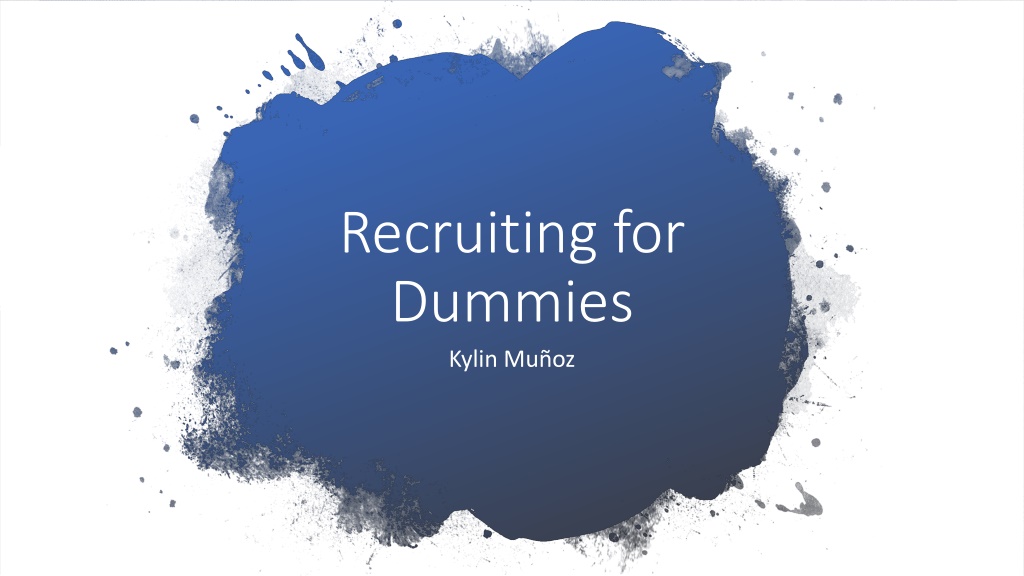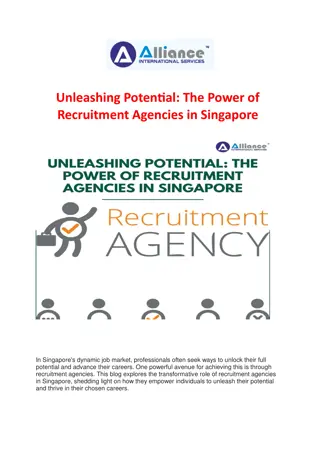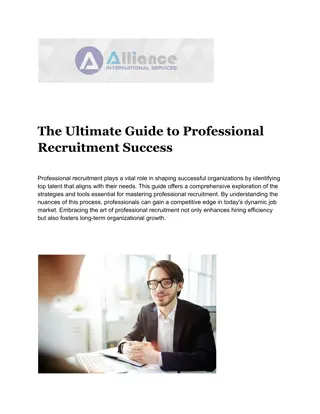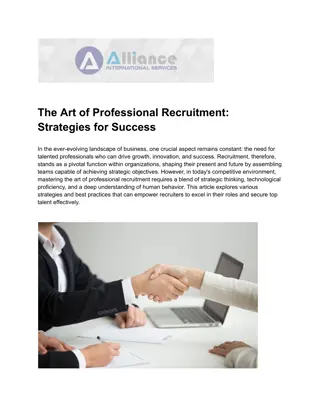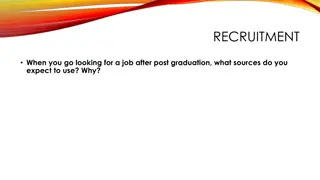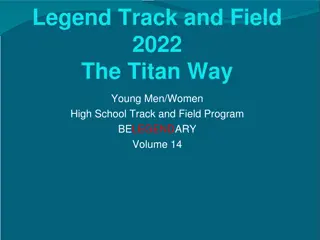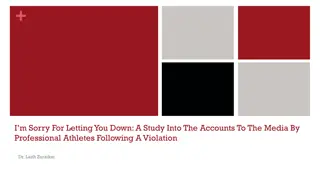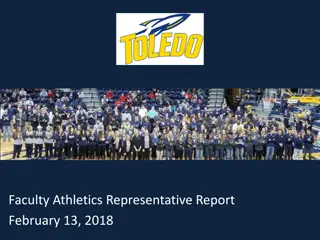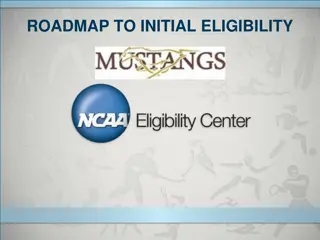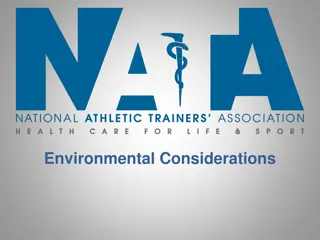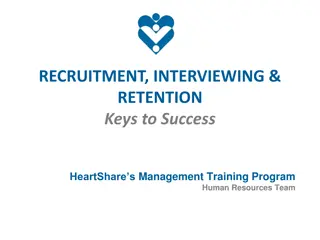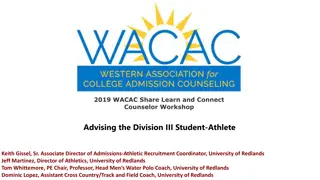Ultimate Guide to College Recruitment for Student-Athletes
Explore the essential steps in college recruiting for student-athletes: knowing your needs, identifying values, selecting top schools, and utilizing helpful websites. Discover valuable insights on fields of interest, campus environment, and evaluating schools based on your values.
Download Presentation

Please find below an Image/Link to download the presentation.
The content on the website is provided AS IS for your information and personal use only. It may not be sold, licensed, or shared on other websites without obtaining consent from the author. Download presentation by click this link. If you encounter any issues during the download, it is possible that the publisher has removed the file from their server.
E N D
Presentation Transcript
Recruiting for Dummies Kylin Mu oz
Recruiting services are a waste Recruiting services are a waste of money! of money!
Where to even begin? Where to even begin? Know what YOU need Know what YOU need
Start with the end in mind You are a STUDENT before an athlete because at some point volleyball will end Career fields/Learning Environment Personality tests/Strength tests/Aptitude test
What do you value? Diversity in student population Respected academics Prestigious athletics Campus environment Class size Facilities Mentor programs Opportunities for internships Time commitment Distance to family Distance to airport Commuter school Size of city Programs Living Situation Things to do in the community Team structure Student-athlete resources Players Coaches School Spirit School Structure Social Opportunities Conference
Remember there are many schools you could potentially be happy at Pick your top 3-5 values and fields of interest. You will use these when researching and evaluating schools: Values Diversity in student population Size of city Prestigious athletics Respected academics Fields of Interest Working with people Opportunities to build relationships Social Work Sociology Communications
Now that I know WHAT I am looking for, I can begin looking at schools Consider creating a spread sheet with your values/ programs and 20 schools Helpful websites: https://web3.ncaa.org/directory/memberList?type=1 http://www.ncaa.org/about/resources/research/ncaa- member-schools https://www.ncsasports.org/womens- volleyball/division-1-colleges
Division I Division II Division III Search Divisions: http://www.ncaa.org/abou t/resources/research/ncaa -member-schools School websites: https://web3.ncaa.org/dir ectory/memberList?type= 1
Division I Head count sport all DI scholarships are full-ride 334 Division I Schools Highest level = highest time commitment Division II 51.6% of DII schools have fewer than 2,500 students High level but with smaller institution Equivalency sport- coach can split up scholarships so only most impactful players may receive full-rides
Division III Smaller more intimate campuses with emphasis on academics Has the most member institutions offer women s volleyball Does not offer athletic scholarships but offer many other scholarship opportunities NAIA Institutions are allowed to manage their own recruiting process (no timeline or calendar) Level is comparable to NCAA DII Can provide a maximum of 8 scholarships Volleyball is considered an equivalency sport, coaches can split up their scholarship dollars however they want
Junior Colleges For many athletes opportunity to complete generals, boost GPA, develop physically Division 1 NJCAA volleyball: can provide full-ride athletic scholarships (tuition, books, fees, and room and board), plus up to $250 in course-required supplies. Division 1 NJCAA volleyball schools are also allowed to provide athletes with transportation costs once per academic year to and from the college by direct route. Division 2 NJCAA volleyball: Colleges may grant athletic scholarships, but scholarships are limited to tuition, books, fees and up to $250 in course-required supplies. Division 3 NJCAA volleyball: Colleges are not permitted to offer any athletic scholarships.
Contacting Schools
After identifying a handful of schools it is time for YOU the STUDENT-ATHLETE to contact them 1. Go to school s website where you can find the staff s email addresses Email should contain: Graduating Year Name Height Position Approach Jump 1-2 sentences why their institution Highlight film- Short clips of skills and end with full set/match Just like volleyball SIMPLE is better than complex
Take initiative, dont wait to have schools approach you University Athlete During tournaments text the coach an update Monthly email should suffice and you can use a similar template for each school Be honest with yourself, your needs, your level Ask for honest feedback about where you stand with coaches Weigh pros and cons but ultimately know that no matter where you go there will be challenges
NCAA DI Recruiting Rules **June 15 after sophomore year** New rules prohibit any communication with student-athlete or parent/guardian and a DI coach before this date Communication includes: text, phone call, email conversation and verbal offer Can not have recruiting conversations at college camps/clinics until this date Official/ Unofficial visits starting August 1st of Junior year Unofficial: paid entirely by student-athlete Official: paid by institution and only allowed 5 official visits
Club coaches/club recruiting coordinator are key before June 15th of sophomore year. Your club coach can have discussions with schools regarding their needs. Camps are key: Shows your interest in a school Allows you to see facilities/players/coaching style/campus Allows coaches to work one on one with you Take a campus tour
Tips for Parents Your child is the student-athlete Your role ultimately is to support your child-know your place Help prepare your student to live an independent life (time/ money management, cook, clean, productive study habits) Tips for Student-athletes Take responsibility and initiative Know that it is ok to be rejected and is not a reflection of your worth Recruiting takes extra worth but never lose the fun in sports
